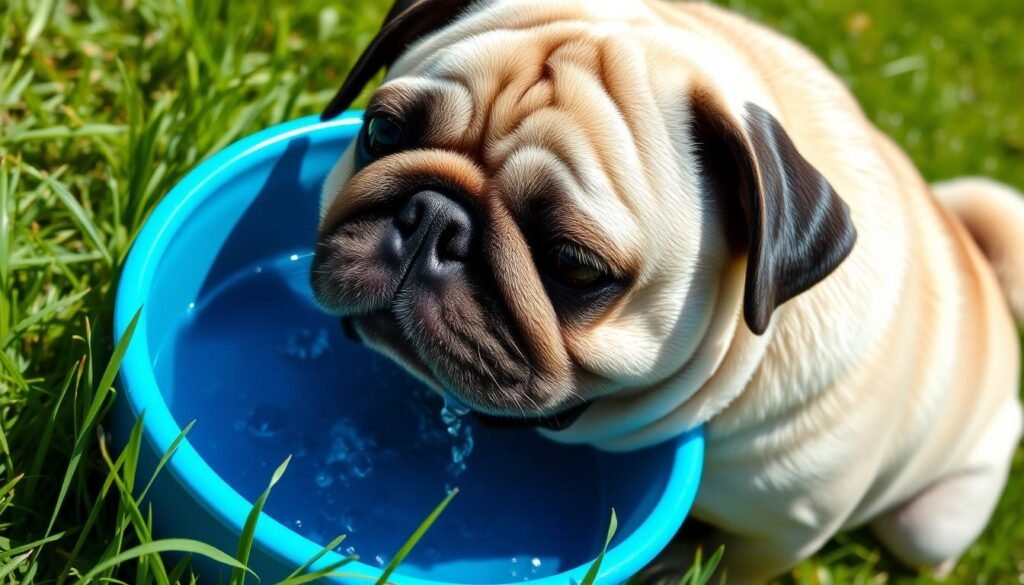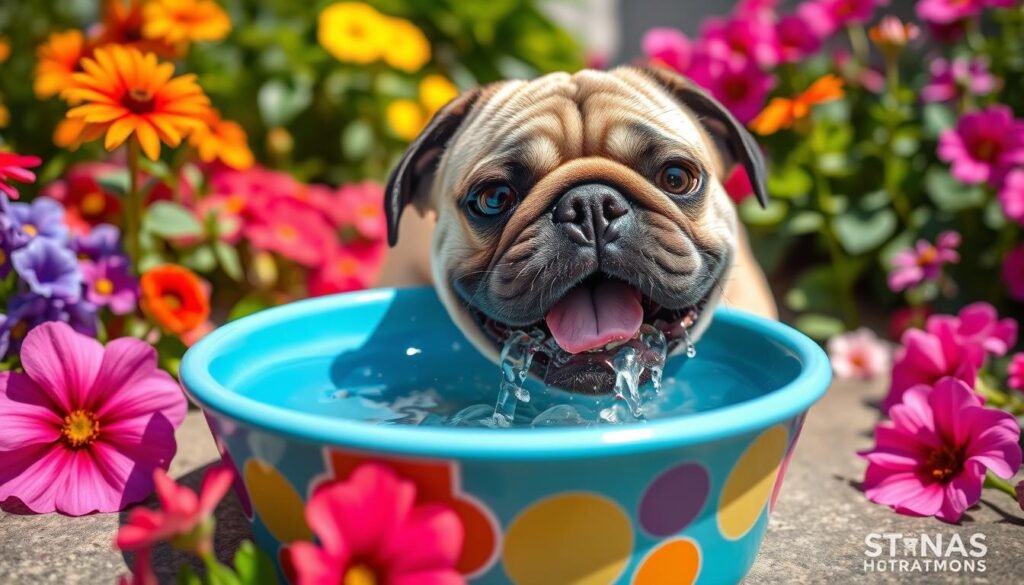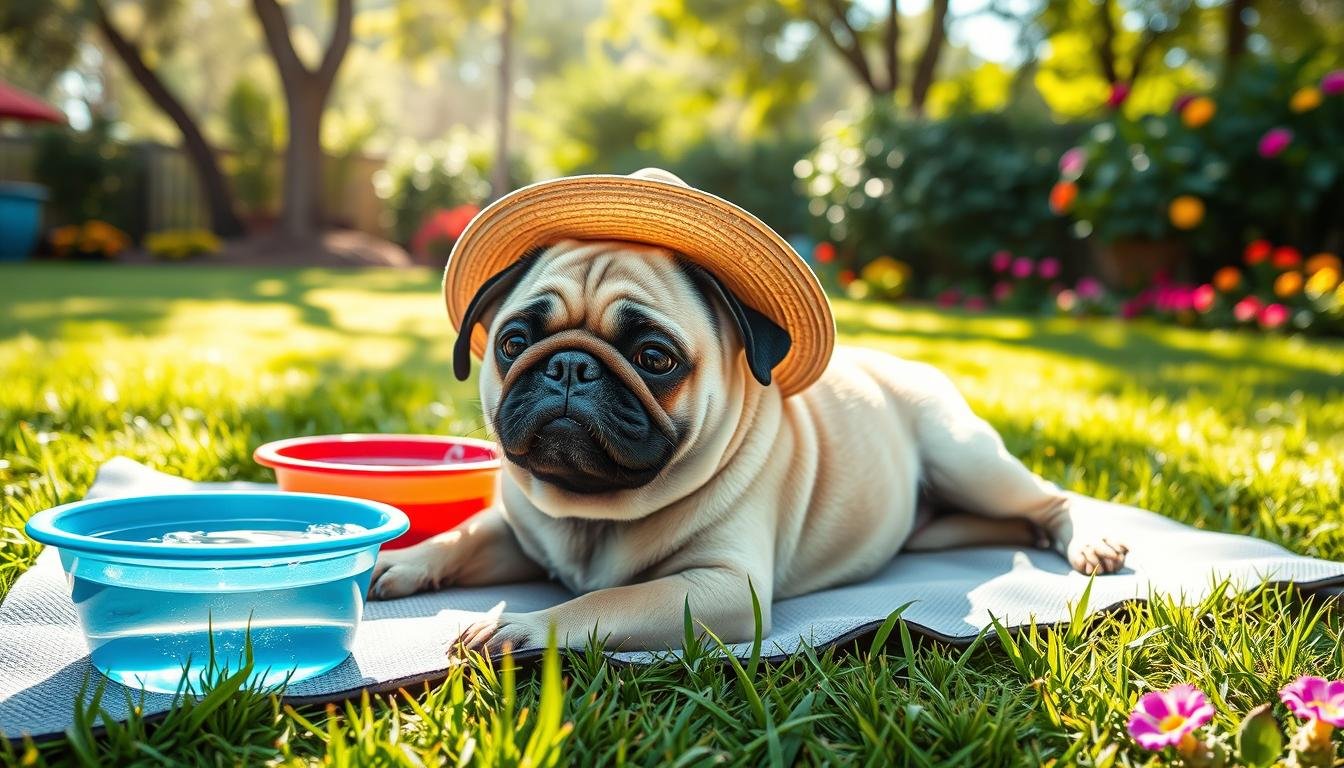How to avoid dehydration in Pugs during hot weather
Did you know Pugs are more likely to get dehydrated than many other dogs? A study showed Pugs can lose up to 10% of their body weight in water in just a few hours of hot, humid weather. This highlights the importance of keeping Pugs hydrated and safe in the heat.
Pugs have wrinkled faces and short snouts, making them more sensitive to heat. They can get dehydrated quickly in hot weather. Dehydration can cause serious health issues in Pugs, like lethargy, organ failure, and even death. It’s crucial for Pug owners to ensure their pets stay hydrated and safe during summer.
Importance of Hydration for Pugs

As a Pug owner, keeping your dog hydrated is key, especially in summer. Pugs, with their short snouts and thick coats, can’t handle heat well. So, making sure they drink enough water is very important.
Pugs and Heat Intolerance
Pugs can’t cool down as well as other dogs because of their short noses. This makes them more likely to get heatstroke. They also lose a lot of water through panting and drooling, which can make dehydration worse.
Consequences of Dehydration in Pugs
Dehydration can be very dangerous for Pugs. It can lead to organ failure, shock, and even death. Signs of dehydration include a lot of panting, dry gums, feeling tired, not wanting to eat, and skin that doesn’t snap back.
It’s vital to keep Pugs hydrated to help them stay healthy and cool. As a Pug owner, making sure they drink enough water is your main job, especially when it’s hot.
“Proper hydration is the key to a healthy and happy Pug, especially in hot weather. Don’t let dehydration put your beloved companion at risk.”
Signs of Dehydration in Pugs

It’s important to know the signs of dehydration in Pugs to avoid bigger problems. Pugs, with their flat faces, can easily get too hot and dehydrated. Checking their gums and skin can help keep them hydrated. They might not always tell you they need water.
Dry, Sticky Gums
Dry, sticky gums are a key sign of dehydration in Pugs. Healthy Pugs have moist, slick gums. If your Pug’s gums are dry and sticky, they might not be drinking enough water. You can check their hydration by gently pressing on their gums and seeing how fast they refill.
Lethargy and Loss of Appetite
Dehydrated Pugs often seem tired and don’t want to eat. If your Pug is acting sluggish or not interested in food, they might need more water. Watching how active they are and how much they eat can help spot dehydration early.
“Dehydration can be a serious concern for Pugs, as their flat faces and compact bodies make them more susceptible to heat-related issues. Staying vigilant for the signs of dehydration can help you keep your Pug happy and healthy, even on the hottest days.”
Knowing the signs of dehydration in Pugs helps you keep them hydrated and comfortable, even when it’s hot.
Preventing Dehydration in Pugs During Summer

Keeping Pugs hydrated is key, especially in the summer. Make sure they always have fresh, clean water. Change their water often and put water stations around the house.
Providing Fresh, Clean Water
Pugs need at least one ounce of water per pound of body weight daily. Use cool, clean water and change it often. A pet water fountain can also encourage them to drink more.
Adding Water to Pug’s Food
Adding water to your Pug’s food can also help. This is especially useful in summer when they might drink less. Mix a bit of water into their food to boost their fluid intake.
Even a little dehydration can be risky for Pugs. Watch their water intake closely. If you think they’re dehydrated, get vet help right away.
How to Avoid Dehydration in Pugs During Hot Weather

Keeping Pugs hydrated is key, especially when it’s hot. These cute, flat-faced dogs can get dehydrated fast. To prevent this, follow a few easy steps to keep your Pug safe and cool this summer.
First, ensure your Pug always has fresh, clean water. Fill their water bowl often and place extra bowls around the house. You can also add water to their food to boost their hydration.
When it’s hot, limit your Pug’s outdoor time to cooler hours like morning or evening. Use shaded spots, cooling mats, and fans or AC to keep them comfy and hydrated.
It’s also important to watch your Pug’s hydration. Check their gums and skin regularly for signs of dehydration. If you see dry gums or lethargy, call your vet right away.
By following these tips, you can avoid dehydration in Pugs during hot weather. This will help keep your furry friend healthy and happy all summer.
Creating a Cool Environment for Pugs
Pugs are cute friends, but they can’t handle the heat well. Their short noses and thick fur make them more likely to get sick in hot weather. It’s key to make a cool spot just for them to stay healthy and happy.
Shaded Areas and Cooling Mats
Give your Pug a place to hide from the sun. Use tarps, umbrellas, or trees to make cool spots. Also, cooling mats or pads can be a big help. They soak up heat and let your Pug rest comfortably.
Air Conditioning and Fans
When it’s really hot, air conditioning or fans can be a lifesaver. Set up a cool area in your home. A room with a fan or air conditioner can be a safe haven for your Pug.
Pugs can easily get sick from the heat. So, it’s important to make a cool place for them. With shaded spots, cooling mats, and cool air, your Pug can enjoy the summer safely.
Exercise and Activity for Pugs in Hot Weather
Regular exercise is key for Pugs, but it’s important to limit it when it’s very hot. Schedule walks and playtime for cooler times like early morning or late evening. This helps avoid the summer heat. Also, watch your Pug’s behavior and give them water often to prevent dehydration.
Pugs, being brachycephalic, have a hard time cooling down. Leaving them outside without shade or water increases their risk of heatstroke. To keep your Pug happy and cool, try these tips:
- Offer fresh water frequently to help prevent dehydration.
- Use cooling accessories like mats, vests, and bandanas to help regulate their temperature.
- Give them ice treats made from water or broth to hydrate and cool them down.
- Add fresh fruits and veggies like watermelon, cucumber, and strawberries to their diet to keep them hydrated.
Walking Pugs in the early morning or late evening is best to avoid the heat. Brachycephalic breeds and puppies need extra care because they’re more prone to heat issues. If your Pug shows signs like vomiting, diarrhea, confusion, or unresponsiveness, get them to the vet right away.
“Pausing every 15 minutes for water breaks during outdoor dog exercising activities is crucial,” advises Dr. Stephens.
By being careful with your Pug’s exercise in hot weather, you can keep them healthy, hydrated, and happy all summer.
Monitoring Water Intake and Hydration Levels
It’s crucial to watch how much water your Pug drinks to avoid dehydration. Pugs have short snouts, making it hard for them to cool down in the heat. This makes them more likely to get dehydrated.
Checking Gums and Skin Elasticity
As a Pug owner, check your pet’s gums and skin often. Dry, sticky gums and soft skin are signs of dehydration. Press your finger on your Pug’s gum and see how fast the color comes back. If it takes more than a second, they might be dehydrated.
Another way to check if your Pug is hydrated is the skin elasticity test. Pinch the skin on their neck and see how fast it snaps back. If it takes too long, your Pug might need more water.
By watching how much water your Pug drinks and checking for these signs, you can spot dehydration early. This helps keep your Pug healthy and hydrated, even when it’s very hot.
Seeking Veterinary Care for Dehydrated Pugs
If your Pug shows signs of severe dehydration, like sunken eyes or a weak pulse, get vet care fast. A vet can give your dog the fluids it needs and check for other health problems. This can help your dog recover quickly.
Quick medical help is key for a dehydrated Pug. Dehydration can cause serious health issues. If your Pug isn’t drinking enough or shows dehydration signs, act fast.
VEG has emergency care for pets, open 24/7 all year. If you’re worried about your Pug’s hydration, take them to the vet. Early treatment can prevent bigger problems.

